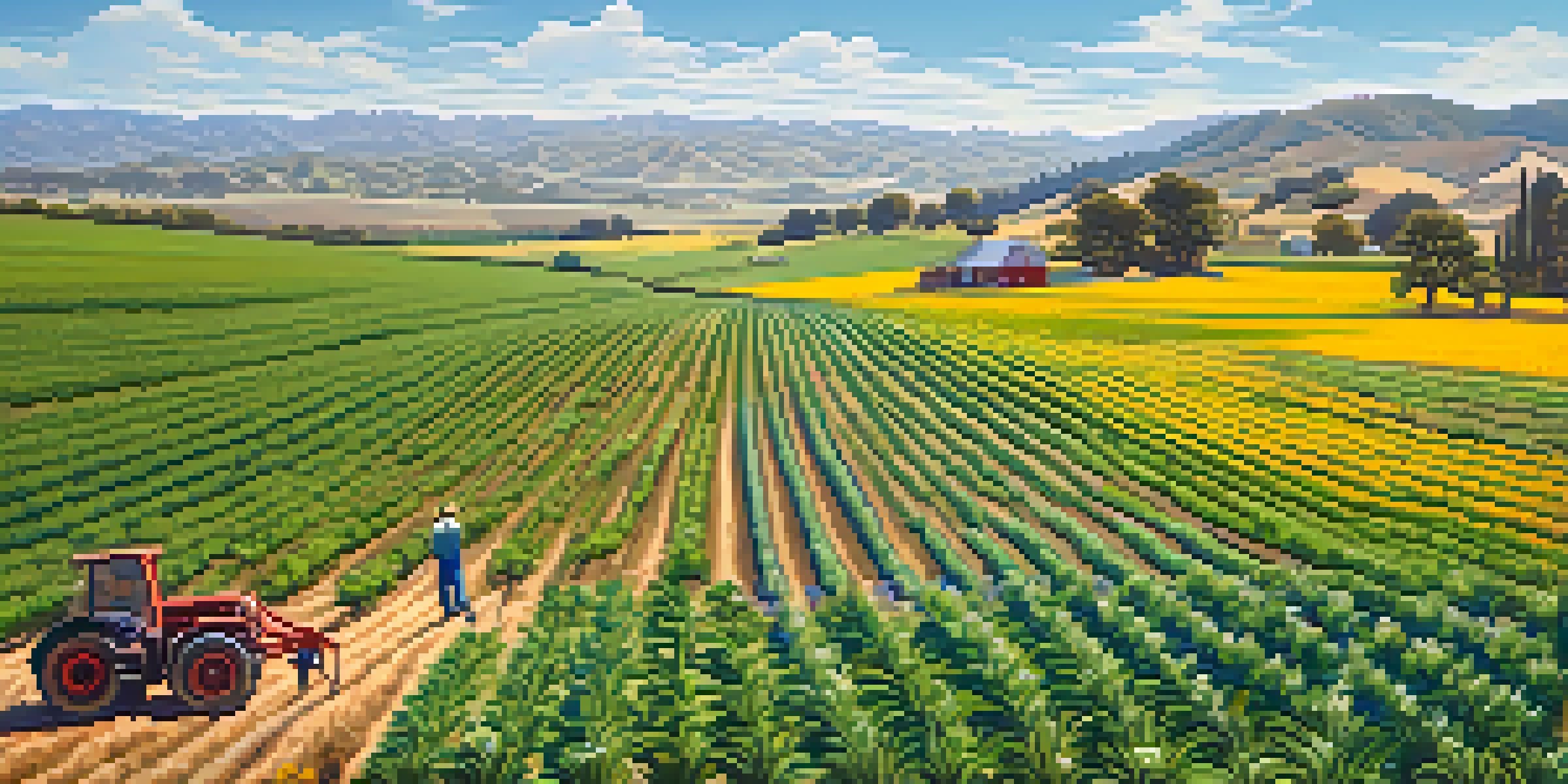California's Diverse Crops: A Historical Overview

The Birth of Agriculture in California
California's agricultural journey began with its indigenous peoples, who cultivated a variety of crops long before European settlers arrived. They practiced sustainable farming methods, growing staples such as acorns, seeds, and wild plants. This deep-rooted connection to the land laid the groundwork for what would become one of the most productive agricultural regions in the world.
Agriculture is our wisest pursuit, because it will in the end contribute most to real wealth, good morals, and happiness.
With the arrival of Spanish missionaries in the 18th century, new crops and farming techniques were introduced. The cultivation of grapes for wine, olives, and citrus fruits started to take shape, demonstrating a blend of Native American practices and European influence. This fusion marked the beginning of a diverse agricultural landscape that would evolve over centuries.
As California transitioned into statehood in 1850, agriculture became a cornerstone of its economy. The Gold Rush not only attracted fortune seekers but also farmers who sought fertile land. This period saw the expansion of crop diversity as settlers experimented with different varieties, setting the stage for the agricultural boom that would follow.
The Rise of Commercial Agriculture
The late 19th century marked a significant shift towards commercial agriculture in California. Innovations in irrigation and transportation allowed farmers to expand their operations and reach broader markets. Railroads, in particular, played a crucial role in transporting fresh produce across the country, elevating California's status as a key agricultural hub.

Crops like almonds, walnuts, and grapes began to dominate the landscape, with California eventually becoming the leading producer of these crops in the United States. The establishment of the California Agricultural Experiment Station in 1888 further propelled agricultural advancements, focusing on research to improve crop yields and pest management.
Agriculture's Rich Indigenous Roots
California's agricultural history began with indigenous peoples who practiced sustainable farming long before European settlers arrived.
This era also saw the emergence of large-scale farming practices, which led to increased productivity but also raised concerns about sustainability and labor practices. The growth of the agricultural sector brought diverse communities together, as migrant workers played an essential role in the industry's expansion.
The Impact of the Dust Bowl
The Dust Bowl of the 1930s had far-reaching effects on California's agriculture, despite the state being less affected than the Great Plains. The economic struggles of the era prompted many farmers to migrate westward, seeking better opportunities. This influx of newcomers brought both challenges and benefits, as they introduced new farming techniques and crops.
The future will be about sustainable agriculture and the role of farmers in shaping and sustaining our food systems.
During this time, the need for sustainable practices became evident. Farmers began to explore crop rotation and soil conservation methods to combat erosion and maintain soil health. This period of reflection ultimately laid the groundwork for a more sustainable agricultural approach in California, as farmers recognized the importance of caring for the land.
The Dust Bowl also highlighted the vulnerability of monoculture farming, where a single crop is grown extensively. This realization pushed California's agricultural community to diversify crops and adopt more resilient practices, setting a precedent for future generations.
Post-War Agricultural Boom
The end of World War II ushered in a new era for California's agriculture, characterized by technological advancements and increased production. The introduction of synthetic fertilizers, pesticides, and machinery transformed farming practices, allowing for greater efficiency and crop yields. This boom made California a major supplier of fruits and vegetables across the nation.
During the 1950s and 1960s, diversification continued to grow, with farmers experimenting with exotic crops and organic farming gaining popularity. This period also saw the establishment of farmer's markets, connecting consumers directly with producers and promoting fresh produce. The agricultural landscape became increasingly vibrant and varied, reflecting the state’s diverse population and climate.
Shift to Commercial Agriculture
The late 19th century saw California evolve into a commercial agricultural powerhouse, driven by innovations in irrigation and transportation.
However, these advancements also led to concerns about environmental impact and food safety. As the agricultural industry expanded, discussions around sustainable practices and organic farming began to gain traction.
The Rise of Organic Farming
The 1970s marked a turning point for California agriculture with the rise of the organic farming movement. As consumers became more health-conscious, demand for organic produce skyrocketed. Farmers responded by adopting organic practices, eschewing synthetic chemicals in favor of natural alternatives, which not only benefited the environment but also improved crop quality.
California quickly became a leader in organic agriculture, boasting a diverse array of organic crops, from vegetables to fruits and nuts. The state's favorable climate and innovative farming techniques allowed it to produce more organic goods than any other state in the U.S. This shift not only catered to consumer demand but also nurtured a culture of sustainability among farmers.
As the organic movement gained momentum, it also sparked a broader conversation about agricultural practices and food systems. Farmers began to collaborate on sustainable initiatives, ensuring that California's agricultural legacy would continue to evolve while respecting the environment.
Climate Change and Crop Adaptation
As climate change continues to impact agriculture worldwide, California's farmers face unique challenges and opportunities. Rising temperatures, changing precipitation patterns, and increased frequency of extreme weather events necessitate adaptive strategies. Many farmers are now exploring drought-resistant crops and innovative irrigation techniques to sustain their livelihoods.
In response to these challenges, research institutions and agricultural organizations are collaborating to develop climate-smart farming practices. This includes not only crop adaptation but also soil health management and integrated pest control strategies. California's farmers are becoming more resilient, embracing change while striving to maintain their diverse crop varieties.
Embracing Organic and Sustainable Practices
The rise of the organic farming movement in the 1970s led California to become a leader in sustainable agriculture, responding to consumer demand for healthier produce.
The ongoing dialogue around climate change is also influencing consumer behavior, with more people seeking locally-sourced and sustainably grown food. This shift is encouraging farmers to prioritize environmental stewardship, reinforcing California's reputation as a leader in progressive agricultural practices.
The Future of California's Diverse Crops
Looking ahead, the future of California's agriculture is bright yet complex. The state's unique climate, rich soil, and innovative spirit continue to foster diversity in crops. However, the challenges posed by climate change and shifting consumer preferences will require ongoing adaptation and resilience from farmers.
Emerging technologies, such as precision agriculture and biotechnology, hold promise for enhancing crop production and sustainability. These advancements can help farmers make informed decisions, optimize resource use, and reduce environmental impact. As a result, the agricultural landscape is poised for transformation, with the potential for even greater diversity in crops.

Ultimately, California's agricultural legacy is a testament to the power of adaptation and innovation. By embracing sustainability and honoring its rich history, the state can continue to cultivate a diverse array of crops that not only nourish its population but also inspire future generations.